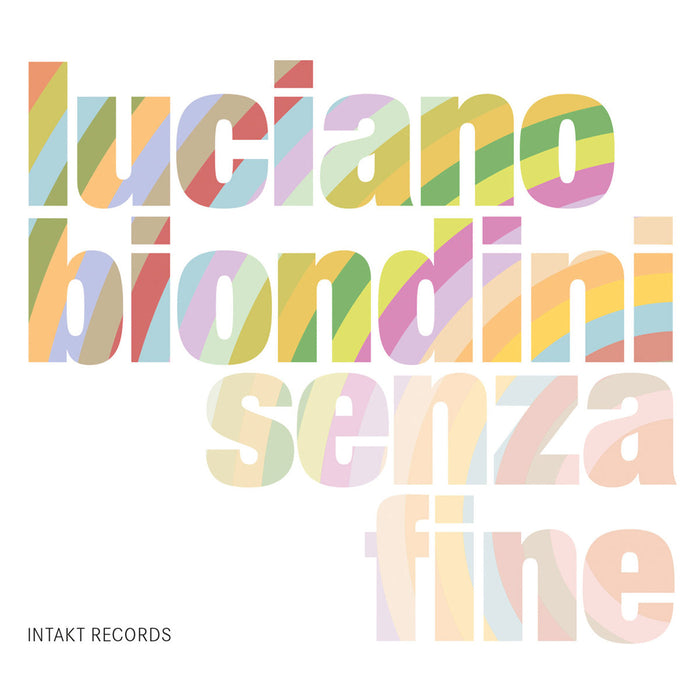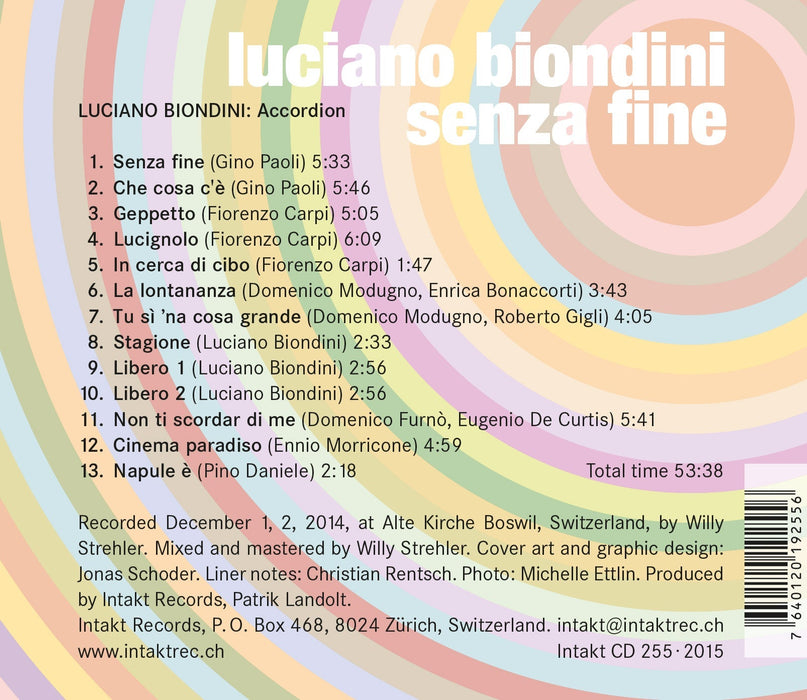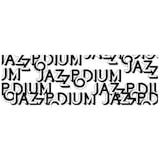


255: LUCIANO BIONDINI. Senza Fine
Intakt Recording #255/ 2015
Luciano Biondini: Accordion
Recorded December 1, 2, 2014 at Alte Kirche Boswil, Switzerland
More Info
Luciano Biondini is one of the few outstanding masters of the accordion in Europe, a musician who is at home with jazz music as well as being deeply rooted in the music of his homeland: the mediterranean. After two CDs with Swiss drummer Lucas Niggli and French tuba player Michel Godard, Biondini has recorded a solo album for the Intakt label, dedicated entirely to the music of the area he grew up in: the city of Spoleto, in Umbria, Northern Italy. His plays some of the great Italian “canzoni” from the 60s, 70s and 80s, which are well know by everyone in Italy. These chart-toppers were sung by Gino Paoli, Domenico Modugno, Ernesto de Curtis and Pino Daniele, the icons of the “Cantautori” scene of that era. One tune is from Ennio Morricone - the melancholic title song for Giuseppe Tornatore’s movie "Cinema Paradiso".
Biondini plays it with passion and emotional power. Jazz critic Christian Rentsch says: “How Luciano Biondini manages it, how he doesn’t give the sentimental melody away right from the start but creeps up on the theme, so to speak, continuously bending it in the course of the piece, playing around it, making it disappear and magically reappear, this shows the mastery.”
Album Credits
Cover art and graphic design: Jonas Schoder
Liner notes: Christian Rentsch
Photos: Michelle Ettlin
Recorded December 1, 2, 2014 at Alte Kirche Boswil, Switzerland, by Willy Strehler. Mixed and mastered by Willy Strehler.
Déjà auteur de deux disques en trio (avec Niggli et Michel Godard), l'accordéoniste italien Luciano Biondini se présente cette fois en solo et réinterprète – il compose également – une série de belles mélodies populaires italiennes, en jouant sur la tradition folklorique méditerranéenne et l'improvisation jazz ; toute la nostalgie poétique que véhicule cet instrument quand il est si bien joué se retrouve dans « Senza fine » (Intakt 255) (OUI, on aime !)
https://www.culturejazz.fr/spip.php?article2855
The title of this irresistible disc comes from the iconic song of the legendary Italian songwriter, Gino Paoli. The lyrics though beautifully suggested are not really missed thanks in large part to the utterly beautiful and husky tomes of Luciano Biondini’s reedy accordion. Further the thirteen-piece disc might easily be said to chart the future of the irrepressible joie de vivre of the accordion. Mr Biondini’s fingers splayed across the buttons of this wonderful instrument employ subtle tempo fluctuations and strategic accents that help give shape and dimension to the music’s harmonic richness. In addition Mr. Biondini’s melodic pointing and vocally oriented phrasing prevent the relentless toccata-like patterns melded into the folk elements of the music from sounding the least bit mechanical and ‘notey’, an achievement easier said than done on this instrument. Italian music is not so much a form or an idiom as it is a texture and if you assemble some of the most memorable music from composers of that country and hear it played by one of the great players on the accordion you might run the risk that a certain sameness might prevail. Happily that’s not the case here. Once again Luciano Biondini proves his reputation as a provocative yet immensely thoughtful programme-builder. His two part invention Libero is one of those masterpieces that go a long way into making a case for Mr. Biondini as being a prime innovator on this wonderfully romantic instrument. The chart in question is so beautifully written that it is hard to any accordion player not wanting to include it in his or her repertoire; the delightful skitterings of the lively dance-like movements also make it an ideal encore, its captivating personality adding to its irresistible charm.
Charm and personality reveal themselves in how freely yet naturally and logically these musical offerings unfold. The variety of moods that this music inspires also makes for a record that is truly memorable. Sinuous melodies are dance-like and it is easy to imagine the music drawing partners together in steamy embrace on and off the dance floor. The high spirits and torrid emotions of the music that unfolds from Luciano Biondini’s accordion can be savoured in all of the pieces especially in the rhythmically zestful Geppetto as well as in the beautifully vocal and melismatic Cinema Paradiso.
The pleasures of this music can be attributed not only to Mr. Biondini’s absolute virtuosity on his instrument but also to the colourful arrangements. These are wondrous mixes of melody and harmony played by one of the foremost exponents of the accordion as well. Throughout the disc this young maestro plays with the depth of sonority and rhythmic gusto that this music demands whether it is played in a night club, concert hall, or – as is the case here – in a recording studio where Senza Fine is captured by extraordinary engineering mastery by Willy Strehler for the superb Swiss label Intakt Records.
https://jazzdagama.com/music/luciano-biondini-senza-fine/
Dass Akkordeonisten zu Recht schwärmen, ihr Instrument könne ein komplettes Orchester ersetzen, beweist Luciano Biondini mit seiner neuen Soloaufnahme Senza fine. Darauf blickt der Italiener mit dem Wissen des erfahrenen Musikers auf seine Jugendlieben zurück: Schlager und Canzoni der 60er bis 80er Jahre - Musik, die gar nicht besser zum Instrument passen könnte, mal melancholisch und schwelgerisch, dann leichtfüßig und frisch. Biondini nähert sich den Stücken mit Herzblut, hat aber dennoch genügend Distanz, um nicht in Kitschnähe abzurutschen. Sein Spiel atmet und singt. Und mit der wunderbaren Filmmusik zu Cinema Paradiso kann man ohnehin nichts falsch machen.
Né le 1er janvier 1971 à Spoleto, Luciano Biondini fait partie, aux côtés de Richard Galliano, Jean-Louis Matinier ou Vincent Peirani en France, de Gianni Coscia et Antonello Salis en Italie ou Tuur Florizoone chez nous, de ces musiciens qui ont rendu toutes ses lettres de noblesse à ce que certains appellent le « piano du pauvre », en révolutionnant à la fois ses répertoires et sa technique de jeu. S'il a principalement été révélé au grand public au travers de sa collaboration avec le joueur d'oud Rabih Abou Khalil (« Morton's Feet », avec Giovanni Mirabassi et Michel Godard), Luciano Biondini s'est aussi révélé un partenaire idéal au sein de duos empathiques : avec le saxophoniste argentin Javier Girotto, le trompettiste italien Fabrizio Bosso, le contrebassiste français Renaud Garcia Fons ou sa compatriote Rita Marcotulli (splendide album « La Strada Invisible »). La complicité avec ses partenaires est particulièrement palpable en concert live. Que ce soit avec Javier Girotto (Festival Jazz Brugge 2010) ou Rita Marcotulli (Jazz Brugge 2014), c'est les yeux dans les yeux avec le partenaire qu'il joue, c'est dans le regard de l'autre qu'il lit sa partition. Mais Biondini est aussi un véritable expert du solo comme le montre ce « Senza Fine » enregistré en décembre 2014, pour Intakt, label suisse pour lequel il avait déjà gravé les albums « Mavi » et « What's There What Is Not », en trio avec Michel Godard (tuba, serpent, basse électrique) et Lucas Niggli (batterie). Au travers de cet album solo, Biondini revisite, de manière très personnelle, une série de grands succès de quelques chanteurs-compositeurs populaires italiens, ces « cantautori » qui ont inspiré Paolo Fresu, Enrico Rava ou Tiziana Ghiglioni (son album dédié aux chansons de Luigi Tenco, en compagnie de Gianluigi Trovesi et Paolo Fresu). C'est le cas de Senza Fine, qui donne son titre à l'album, et Che cosa c'è, chansons écrites par Gino Paoli dans les années 1960 et typiques de l'âge d'or de la chanson italienne, celui du Festival de San Remo. Il reprend aussi La lontananza et Tu si'na Cosa Grande de Domenico Modugno, l'auteur des légendaires Volare et Ciao, Ciao Bambina; des titres de Fiorenzo Carpi, comme ce Gepetto composé pour « Le Aventure Di Pinocchio »; d'Eugenio De Curtis (Non Ti Scordar Di Me qu'interpréta notamment Luciano Pavarotti); de Pino Daniele (Napule è) et le thème central de « Cinema Paradiso » écrit par Ennio Morricone. A ces thèmes populaires, viennent s'ajouter trois courtes compositions de Biondini (Stagione, Libero 1, Libero 2) qui s'inscrivent parfaitement dans cette volonté de trouver son inspiration dans cette tradition populaire ancestrale si typique du bassin méditerranéen. Si parfois Biondini se limite à interpréter la mélodie stricto sensu (In Cerca Di Cibo, La Lontananza, Napule è), il la développe souvent de manière totalement personnelle, en la prolongeant dans de surprenantes improvisations (les quelque deux minutes trente de Senza Fine, Che cosa c'è ou Lucignolo passent à 5 à 6 minutes). Il fait alors preuve d'une étonnante indépendance entre les deux mains : il réussit cette performance de jouer la ligne mélodique d'une main, tout en répétant en parallèle, de l'autre, un motif obsessionnel de basse, tel un bourdon. Parfois, la mélodie s'accompagne d'un motif rythmique, en utilisant le corps de l'accordéon comme instrument de percussion (Libero 1). En fait, que ce soit sur tempo lent (Cinema Paradiso) ou rapide (Napule è, Senza Fine), il se dédouble pour dialoguer avec lui-même. Un album gorgé d'émotion.
http://jazzaroundmag.com/?p=10304
Domenico Modugno und Gino Paoli waren in den 60ern richtige Stars des italienischen Liedermachertums, quasi Cantautori der ersten Stunde. Auf seiner neuen Platte hat der Akkordeonist Luciano Biondini dieses Kulturgut, das primär beim Songfestival in San Remo an der Riviera angesiedelt war, ausführlich gewürdigt. Dazu kommt noch ein wenig Filmmusik von Fiorenzo Carpi und eine Nummer des großen Ennio Morricone. Die Schlager werden von Biondinis Akkordeon solo in einen neuen recht angenehm leicht zu hörenden Kontext gesetzt. Viel Sentiment, viel Italianita, zweifellos höchst virtuos intoniert. Insgesamt vielleicht ein wenig zu viel Quetsch'n, an die Einspielungen Biondinis mit dem argentinischen Saxofonisten Javier Girotto recht das Ganze nicht heran, an sein Trio mit Michel Godard und Lucas Niggli schon gar nicht. Als Erinnerung an die letzte Ferragosta ist die Aufnahme allemal geeignet.
Luciano Biondini hat sich auf seinem zweiten Solo- album ausschliesslich Songs gewidmet, die seine Jugendzeit prägten. Die Aufnahmen wurden in der Kirche Boswil gemacht, den Probegalopp dazu absolvierte der Italiener live beim letztjährigen "unerhört!"-Festival. Der Titelsong stammt von Gino Paoli, einem Cantautore der Genueser Gruppe, der in den Sechzigerjahren unvergessliche Lieder schrieb, die mehr als nur eine Generation prägten. Weitere Songs sind von Domenico Modugno und Fiorenzo Carpi, von dem er drei ergreifende Melodien aus. dem Pinocchio-Film fürs TV von Luigi Comencini aus den 1970er-Jahren übernommen hat. Unvergessen sind auch Ennio Morricones Titelmelodie für "Cinema Paradiso" sowie "Napule è" von Pino Daniele, mit welchen Biondini das Album auf dem emotionalen Höhepunkt abschliesst. Dazu kommen drei Eigenkompositionen, die das inspirierte und ausdrucksstarke Soloalbum abrunden. Biondini liefert hier ein starkes Zeugnis seiner impressionistischen Fähigkeiten und hat den Mut, sich der po- Dulären Musikwelt zu widmen, einfache, ans Gemüt gehende Melodien mit seiner unvergleichlichen Kunst zu gestalten, oder anders gesagt: Zu Tränen -ührende Musik auf höchstes Niveau zu heben, ohne dass der Verdacht von Kitsch aufkommt.
Mit Senza Fine (Intakt CD 255) schwelgt LUCIANO BIONDINI in den Schlagern und Ohrwürmern seiner Kindheit, einer italienischen Kindheit. Die Lieder, die Fiorenzo Carpi 1971 für Le avventure di Pinocchio geschrieben hat, beschallten seine Wiege. 'Senza fine' und das wehmütige 'Che cosa c'è' von Gino Paoli, einem der Erz-Cantautori, pfiffen die Spatzen von den Dächern. Von Domenico Madugno, der Ende der 50er mit 'Volare' berühmt geworden war und der sich auf seine alten Tage für die Radicali Italiani engagierte (ähnlich wie Paoli bei der KPI), stammen 'La lontananza' und der Tränenquetscher 'Tu sì 'na cosa grande', dessen Walzernatur Biondini verwischt. Mit 'Non ti scordar di me' hatte Beniamino Gigli 1935 im Film "Vergiss mein nicht" die deutsch-italienische Achse beschmalzt, Pavarotti und Domingo ließen den Schmachtfetzen nicht verrotten, Biondini kehrt seine Melancholie hervor. So trifft er auch den Grundton von 'Cinema paradiso', 1988 Morricones Titelmelodie für Giuseppe Tornatores nostalgischen Herzensbrecher. Pino Danieles 'Napule è' von 1977, das zu Neapel gehört wie der SSC, wird dagegen, Kitsch hin, Melodienseligkeit her, durch Tempo etwas entsülzt. Biondini kostet mit dem Akkordeon alles Blau der Gefühlsskala rund ums Mare Nostrum von Sizilien über Rom bis Cannes weidlich aus. Das italo-französisch-argentinische Temperament und Feeling, das Richard Galliano mit seinen Musettes Neuve und Tangos Nuevo aus dem Akkordeon quetschte, ist auch für Biondini die Teigmasse, in der er die Lust auf Kitsch und die Angst vor falschen Gefühlen umformt in Pasta, mit der er einen päppelt und verwöhnt wie eine Mamma. Bei Mirabassi, Abou-Khalil und Balducci und mit Rita Marcotulli oder Godard & Niggli ist seine Stimme eine von zweien, dreien oder vielen. Hier hat er es allein in den Händen, sich diese Leihgaben und drei eigene Stücke vorzuknöpfen und kapriziös zu schillern und zu quieken, virtuos zu trillern und zu zucken, opulent zu rauschen und melodientrunken zu flöten, dass die Lust auf Lust und die Sehnsucht nach Glück endlos sind.
Luciano Biondini, der Akkordeonist, der in einigen der letzten Projekte von George Gruntz im kleinen Rahmen des Trios, aber auch im opulenten Kontext von Großformationen wie der NDR Big- band oder seiner eigenen Concert Jazz Band, eine maßgebliche Rolle spielte, erinnert auf seinem neuen Album „Senza Fine" daran, dass ein mit allen handwerklichen Finessen hergestelltes Akkordeon schon per se ein Orchester ist und klanglich nur noch wenig zu tun hat mit jenen vorsintflutlichen Quetschen, die ein Musiklexikon von 1880 mit den Worten beschreibt: „Der Klangcharakter des Akkordeons entbehrt jedes Adels und jeder Schönheit...und diese Eigenschaften stempeln es zum geeigneten Dolmetscher des Gassenhauers."
Genau dieses Dolmetschen ist das Anliegen des 1971 in Spoleto, nicht allzu weit von der Akkordeonhochburg Castelfidardo, geborenen Virtuosen. Er will auf seiner Victoria, einem klanglich hervorragenden Knopfinstrument, das unter anderem auch von Richard Galliano geschätzt wird, zwar nicht gerade Gassenhauer, aber doch populäre italienische Lieder in eine Art von Jazz übersetzen. Das bedeutet wieder einmal: Es geht mehr um das WIE und weniger um das WAS. Und für dieses WIE scheint Biondinis Potential unerschöpflich. Die Balgführung ist meisterhaft, das Balgspiel, ausschlaggebend für Tonbildung, Artikulation und Phrasierung, ebenso makellos wie das Fingerspiel. Das üppige Füllhorn an Gestaltungsmöglichkeiten, die ein gutes Akkordeon bietet-ein Pianist kann da nur leer schlucken - kann zum Abgleiten in Manierismen verleiten. Biondini umgeht diese Gefahr mit Stilsicherheit und Geschmack. Nun zum WAS. Die Auswahl der Liedermacher und Komponisten erstreckt sich (neben Biondini selbst) geografisch über den ganzen Stiefel vom Norden (Gino Paoli, Fiorenzo Carpi) über Rom (Ennio Morricone) bis hinunter nach Süditalien (Domenico Modugno, Eugenio De Curtis, Pino Daniele). Biondini verschlüsselt die teils mehr, teils weniger bekannten Lieder oft so genial, dass ein Anhören des Albums sich unweigerlich zum ver- gnüglichen Melodie-Ratespiel entwikdatiert.
Spätestens nach 10 Minuten, wenn die Melodien ertönen, die Fiorenzo Carpi vor 40 Jahren für die Fernseh- serie „Le avventure di Pinocchio" schrieb, muss man unweigerlich an „In cerca di cibo" von Gianluigi Tro- vesi und Gianni Coscia denken. Nun, Luciano Biondini ist Jahrgang 1971, also mindestens eine Generation jünger, aber es scheint ihm ein Anliegen gewesen zu sein, für diese Akkordeon-Solo-CD ein paar Lieder aufzunehmen, die ihn durch seine Kindheit begleiteten. Mit Kompositionen von Gino Paoli, Domenico Modugno, Pino Daniele und Ennio Morricone (ein herrlich getragenes „Cinema Paradi- so") gelingt es Biondini, die schwel- gerische Note dieser Musik nicht zu unterdrücken, ohne in Kitsch und Sentimentalität zu verfallen. Eine sehr italienische CD mit einem umspielenden, andeutenden, streichelnden Akkordeonvirtuosen.
CD-Tipp: Luciano Biondini: Senza fine
Melodienselige Italo-Melancholie auf dem Akkordeon
Das Akkordeon, oft als altmodisches Schifferklavier denunziert, erlebt seit einigen Jahren eine regelrechte Renaissance. Auf Jazz- und Weltmusikbühnen ist es längst ein gern gesehener Gast, zuletzt etwa beim Gala-Doppelkonzert der Jazzahead mit Richard Galliano und Vincent Peirani. Zu den gefragtesten Akkordeon-Interpreten zählt auch Luciano Biondini, der mit "Senza fine" – zu deutsch "Ohne Ende" ein neues Solo-Album veröffentlicht hat.
Bereits als Zehnjähriger begann der in Umbrien geborene Luciano Biondini Akkordeon zu spielen, wohlgemerkt die klassische Variante. Als Jugendlicher heimste er einen Virtuosenpreis nach dem anderen ein, legte schließlich mit 19 Jahren die verrufene Quetschkommode zur Seite und arbeitete lieber in einer Fabrik.
Verrufene Quetschkommode versus Jazzavantgarde
Nach fünf Jahren Bedenkzeit kramte er das Instrument wieder hervor und begann 1994 eine zweite Karriere. Sein Vorbild: der Italo-Franzose Richard Galliano, der das Akkordeon längst aus den Fängen biederer Volksmusik befreit und in Jazzkreisen etabliert hatte.
Auf "Senza Fine" befaßt sich Biondini nun mit den Schlagern seiner Heimat, vorzugsweise von den 1960ern bis in die 1980er Jahre, etwa von Domenico Modugno. Dessen legendäre Songs wie "Volare" oder "Ciao, ciao, bambina" sind ja auch hierzulande Evergreens. Biondini knüpft sich derweil zwei weitere, ebenso schwärmerische Liebeslieder von ihm vor.
Im Rausch italienischer Schlagermelodien
Luciano Biondini berauscht sich geradezu an den Melodien ohne dabei in kitschige Rührseligkeit abzudriften. Seine swingende Jazzphrasierung verhindert allzu volkstümelndes Schunkeln, zugleich sprudelt der Ausnahmeakkordeonist vor Spielfreude und schwelgt in Kindheitserinnerungen.
Da waren zum Beispiel die Fernsehfilmmusiken von Pinocchios Abenteuern, deren klanglicher Schönheit sich Biondini bis zum äußersten hinzugeben scheint. Wer da keine Gänsehaut bekommt, mag wirklich kein Akkordeon!
Nur selten, insbesondere bei einer Eigenkomposition, wagt sich Biondini in experimentellere, geräuschhafte Gefilde. Solche Passagen sind indes die Ausnahme. Biondini hängt viel zu sehr an den harmonisch-versöhnlichen Klängen und stellt seine Virtuosität und Ausdrucksstärke ganz in den Dienst der Melodie.
Besser als so manche Heldentenorversion
Das Album ist für Akkordeon-Freaks eine wahre Sinnesfreude und bedient zugleich den gemeinen Italien-Liebhaber, etwa beim gut 100 Jahre alten Klassiker "Non ti scordar di me", "Vergiß mein nicht". Biondinis beseelte Interpretation braucht den Vergleich mit keiner Heldentenorversion zu scheuen.










